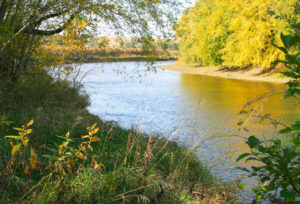
The Big Sioux River, Iowa’s western border. Photo by Carson Ode
By Carson Ode
The borders, sections and quarter sections of Osceola County were platted in 1851. The prairie grassland with small groves of trees initially held limited interest — there was no land rush. It developed a reputation as the “great American desert.” Desert, of course, is a misnomer for any of Iowa’s soil, the richest in the world. Also, the sloughs, swamps and ponds sprinkled across northwest Iowa’s natural landscape did not fit a desert description. However, there were many challenges for the region’s pioneers in the last half of the 19th century.
Prior to white settlers, there was an Indian community of 5,000, known as Blood Run, that straddled the Big Sioux River in what is now Lyon County and South Dakota. Western Plains Indians and Eastern Indians gathered in Blood Run to trade and socialize. The residents built hundreds of permanent, circular lodges. Women made pottery, cooked meals, cleaned animal hides, worked gardens and processed grain. Men made bows and arrows, gathered wild plants and engraved tablets. They raised corn, beans, squash and sunflowers.
The first foreign threat to this culture was French fur trappers who began arriving in 1700. Having an immune system that could not fight European diseases proved to be the downfall of Blood Run’s residents. By 1725, the traditional Oneota culture had all but disappeared. This introduction to white men may have been a factor in the area’s Sioux Indian tribes’ more hostile nature towards pioneers that was experienced in the rest of the state.
Fear of Indians was just one of the factors in the slow settlement of northwest Iowa. In 1858, hordes of blackbirds gorged on enormous amounts of grain. There were too many to shoot. Screaming children ringing cowbells and drumming on tin pans had some effect. From 1873 to 1877, grasshoppers annually consumed virtually every plant in their path — they blotted out the sun. Prairie fires and floods added to the challenge. The swamps and sloughs were infested with snakes, rodents and wild game and not fit for farming. One winter in the 1850s, trappers harvested $7,000 worth of pelts from this wild game. During another winter, trappers may have been stymied by a snowfall of four feet. Using the word “blizzard” to describe a whiteout snowstorm first appeared in print in an 1870 edition of the Northern Vindicator, an Estherville newspaper. It was coined by editor O.D. Bares.
Many of the sloughs, swamps and ponds of northwest Iowa could be traversed for more than a mile in a canoe, weaving in and out. This watery terrain has an exclamation point in the Iowa Great Lakes region. There is no limit on the size of the boats that can be launched in these waters. Spirit Lake is Iowa’s largest at 5,684 acres. It has a shoreline of 15.25 miles and an average depth of 17 feet with a maximum depth of 24 feet. West Okoboji Lake is 3,847 acres with 19.8 miles of shoreline. The average depth is 38 feet with a maximum of 136 feet making it Iowa’s deepest lake. East Okoboji Lake is 1,835 acres with an average depth of 10 feet and a maximum depth of 22 feet. Smaller pond-size lakes also pepper the area. Today a million visitors a year enjoy the recreation offered, as well as the beauty of the Iowa Great Lakes. This was not always the case. In the winter of 1856–57, different unwelcome visitors arrived causing a great tragedy in the region.
TO READ THE ENTIRE STORY AND OTHER FASCINATING STORIES ABOUT IOWA HISTORY, subscribe to Iowa History Journal.
